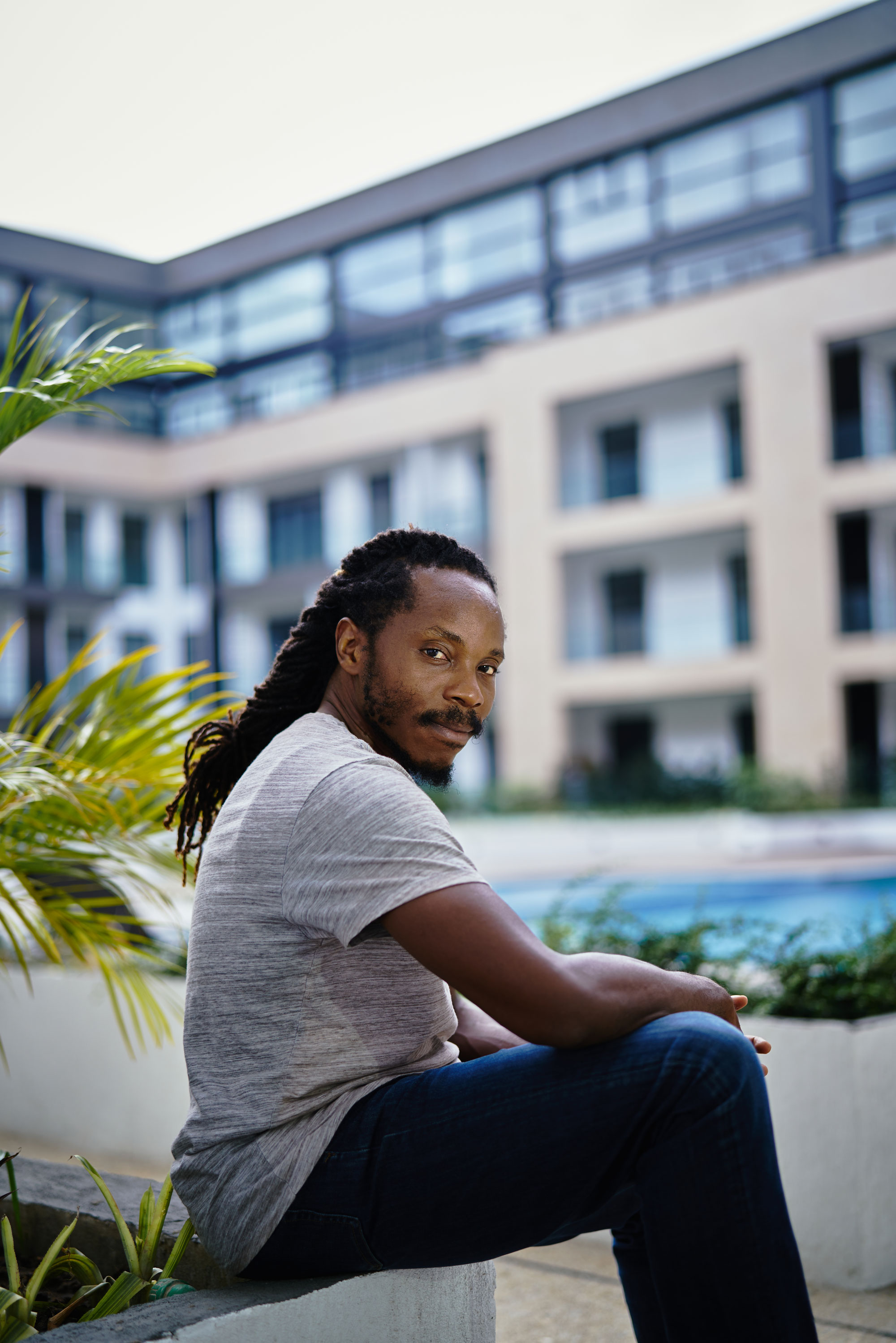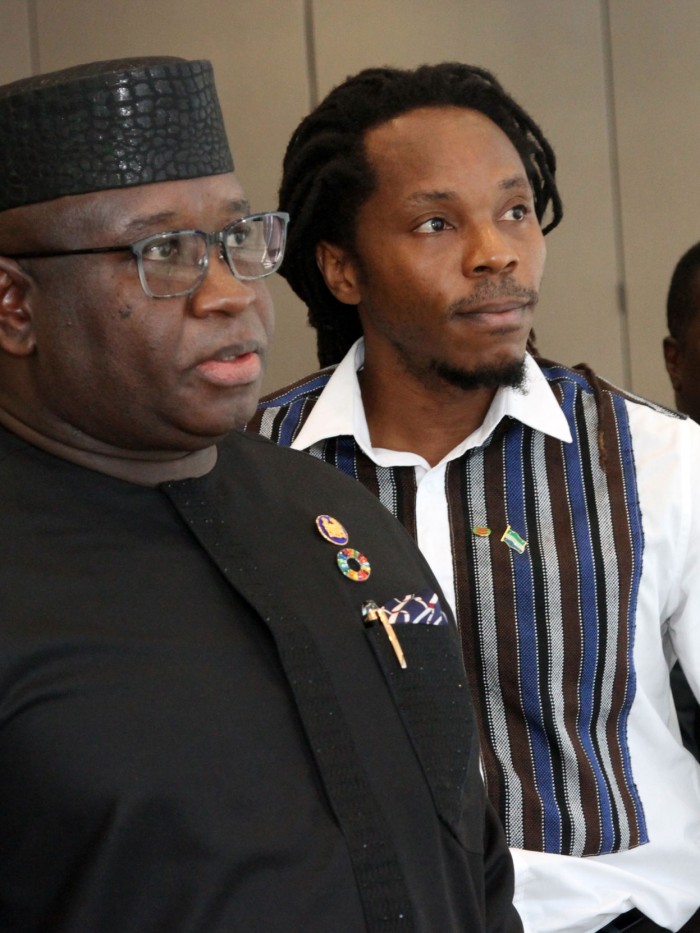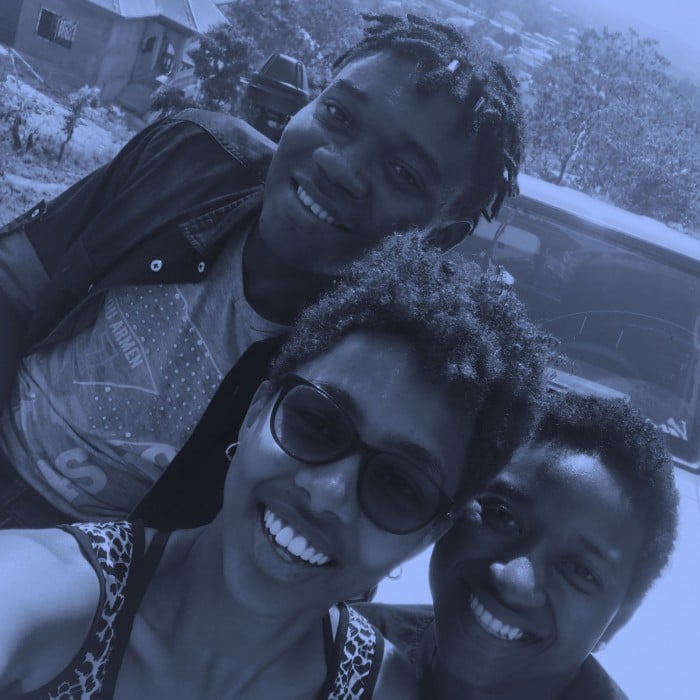Innovator in chief

The Directorate of Science, Technology, and Innovation building in Freetown, Sierra Leone, is not your average state office. On a given day, people might be clustered around a 3D printer or a mapping program. Others might be heading outside for a football break, a standup meeting in the courtyard, or a data-crunching session in a hammock under the trees. In the middle of it all will be a man with kind eyes, dreadlocks, and colorful socks, giving someone his rapt attention.
DSTI is one of Sierra Leone’s newest directorates. And the figure at the center is Moinina David Sengeh, PhD ’16, a native of the country and its first chief innovation officer.
For the past year, Sengeh and his colleagues have been approaching some of the country’s most pressing issues—from water security (see “On the level,” below) to education access—with a boldness and creativity not often found in government, eschewing rigid roles and bureaucracy in favor of hackathons (see “Back to school,” below) and interdisciplinary teamwork.
DSTI is “in the Office of the President,” Sengeh says. “But I usually say, ‘Let’s go to the lab.’”
Away from home, and back again
Like his methods, Sengeh’s journey into government was unorthodox. After completing high school in Sierra Leone, he earned a scholarship that led to two years at the UWC Red Cross Nordic College in Norway, an International Baccalaureate school whose students are from more than 80 countries. He then spent his undergraduate years at Harvard, where he worked on new forms of vaccine delivery, and began a PhD at the Media Lab—“the only place that would allow me to play,” he says.
“A lot of international development ends up being technology-led, and not led by local needs.”
There, Sengeh designed award-winning prosthetic sockets, inspired by the thousands of people injured during Sierra Leone’s civil war of the 1990s and early 2000s. Sengeh had noticed that although amputees in Sierra Leone were often given prosthetics, many didn’t use them because they chafed or bruised. Using precise measuring tools, algorithmic design, and 3D printing, he found a way to create personalized sockets that fit comfortably.
While prototyping, he got help from veterans and an amputee from the Boston Marathon bombing—and from his advisor, biomechatronics professor Hugh Herr, who lost his legs in a climbing accident decades ago. “Being able to test things on him, with him, was a different level of empathy in design,” says Sengeh.


As a PhD student (left), Sengeh developed personalized sockets for prosthetics. In March 2019, he returned to MIT with Sierra Leone’s president, Julius Bio, to discuss possible research partnerships.
Along the way, he became a TED Fellow and a National Geographic Emerging Explorer. He also found time to start his own clothing design company and release some Afrobeat rap songs.

On the level
Christabel Sitienei ’19
Over a million people live in Freetown—but most of Sierra Leone’s water sources are hundreds of miles away in the high-lands. So parts of the capital rely on large water tanks, which get topped off by trucks that travel back and forth.
Figuring out when to refill them is tricky; after citizens report a low tank, an employee must verify the level. “The process is very long and arduous,” says Christabel Sitienei ’19 (above, center), who spent her last IAP working on the problem with DSTI.
Along with a Sierra Leonean engineer, Ernest Kamara, Sitienei designed a real-time water monitoring device. Its main component is a float switch, which “sends a signal when the water drops below a certain level,” says Sitienei. That triggers a battery-powered microcontroller, which sends a text message to the people responsible for refilling the tank. Although the device is still in the prototyping stage, the goal is to eventually have one in every tank in the country.
Working on such a scale inspires Sitienei, who was born in Kenya and admires Sengeh’s commitment to his home. “I’m an African who is looking to move back,” she says. She sometimes imagines being in Sierra Leone 10 years from now and watching people use infrastructure that isn’t yet present.
“We are the ones who are struggling to get that set up,” she says. “I feel very privileged.”
But even as he gained success abroad, “my heart was always in Sierra Leone,” he says. He returned every summer with new ideas for local initiatives. He started an NGO, Global Minimum, and a competition, Innovate Salone, both of which focus on empowering young people to find solutions to local problems. (Innovate Salone is now an annual event, attracting hundreds of secondary school students.)
After finishing his PhD in 2016, he joined IBM Research in Nairobi to work on artificial intelligence. At the same time, he was writing to civic leaders in his home country, he says, trying to “understand their views around technology” in order to figure out his own place there.
One of the people he contacted was the politician Julius Bio. The two hit it off: both had young children and a fascination with emerging technologies. And they both thought an administration that decided to “place innovation at the heart of government” could “transform a country,” Sengeh says.
Bio went on to run for president of Sierra Leone. When he won, in May of 2018, he asked Sengeh to put their conversations into practice. As chief innovation officer, Sengeh would have his own team and complete creative control. “I couldn’t say no,” he says. That July he left IBM, moving his family to Freetown.
Land of opportunity
Sierra Leone is still recovering from the legacies of colonialism and the Atlantic slave trade, as well as its civil war. Many citizens lack reliable access to clean water and electricity, and over half live below the poverty line.
In one specific way, Sengeh says, this lack of development is an advantage. Because Sierra Leone doesn’t have “traditional infrastructure and systems in place,” he says, it can make changes more quickly than countries that might have to phase out old methods and implement new ones at the same time.
Take renewable energy or blockchain systems: both are easier to build from the ground up than to shoehorn into existing schemes, he points out.
“Our deficiency is our opportunity to lead,” he says. “Sierra Leone [can] actually be at the forefront.”

DSTI has a few main priorities. The first, Sengeh says, is to support the national development plan, which promotes human capital development through education, health, and agriculture. Its current focus is on education—a critical need in a country where 60% of adults can’t read or write. Last year, a different government ministry collected data on all schools in the country—about 10,000—with hundreds of metrics, from attendance records to exam results.
DSTI members helped clean and pre-process the data, and they are working on machine-learning algorithms to determine which of these metrics are important for learning outcomes, Sengeh says. Officials will be able to use the findings to set policy priorities.
The DSTI group tries to make its tools as widely accessible as possible. At President Bio’s request, they recently created a 3D-printed data map of the country, representing how far children from different areas have to walk to get to school. Longer commutes are represented by taller areas on the map, while brief commutes are shorter. Such maps—physical objects that people can all look at together, without the need for screens or power—are now fixtures in meetings as the government figures out how to distribute buses and where to build new schools. A number of other mapping projects are in progress, including an online portal that will allow people to see, for example, where their local court is located and get more information about the types of disputes it deals with, says Sengeh. The maps also show where such things as schools, health facilities, and cell towers are located.
These efforts exemplify another DSTI priority: putting the people first. “A lot of international development ends up being technology-led, and not led by local needs,” says Ethan Zuckerman, the director of MIT’s Center for Civic Media, a friend and frequent collaborator of Sengeh’s.
“The core of all of this is people,” Sengeh says. “That’s why we do what we do.”
Start in the deep end
Sengeh wants to “make Sierra Leone into an innovation hub.” Here, too, he has the challenge—and the opportunity—of starting from scratch.
He has filled DSTI with engineers, designers, and policymakers. Many are Sierra Leonean, while others—including two MIT professors and nine students from MIT’s MISTI-Africa program—come from around the world to work on projects.
“The core of all of this is people,” Sengeh says. “That’s why we do what we do.”
Students are drawn by the opportunity to make a nation-sized difference, and by Sengeh’s approach to leadership, which emphasizes independence. A DSTI member might spend the morning programming an anti-corruption algorithm, and the afternoon helping set up the free coding school for youth that is poised to open next year.

Back to school
Banti Gheneti ’17, MEng ’19
Too much data can be overwhelming without a way to channel it. Thanks to a country-wide survey done in the fall of 2018, DSTI has access to “gigantic lists of variables” about Sierra Leone’s schools, says Banti Gheneti ’17, MEng ’19 (above, second from left). With the click of a button, DSTI members can tell you about student-teacher ratios, textbook counts, or the number of bathrooms in a particular school building.
So this past July, DSTI went through a rite of passage: its first hackathon. Lab members, ministers, government employees, and visitors from Unicef New York and the University of Pretoria spent 12 days together, talking through strategies and crunching numbers.
“We came in wanting to know what factors affect how well students perform on their final examinations,” says Gheneti, who spent five months in Sierra Leone this year working on various projects. It was also a good opportunity to clean up the data set, and for people with different skills to bring each other up to speed.
Some of the teams’ hunches were borne out. More reliable restroom access does seem to improve test scores, for instance. Most important, Gheneti says, they realized what to improve next time: how to get data that will be more standardized, easier to work with, and more fruitful. (For example, having two school ID numbers muddled their findings.)
“These are really important insights that you get from thinking through a hackathon,” he says. DSTI is working to incorporate these lessons into the next survey.
Or he might arrive and find himself in a meeting with high-ranking government officials just a few days later. That’s what happened to Amauche Emenari, a PhD candidate in computational neuroscience who spent this past January working with DSTI to streamline how funds move within the Sierra Leonean government. In order to apply his insight and experience in this new context, Emenari says, he had to rethink his assumptions about how technology should work.
At first, for example, he couldn’t understand why money transfer involves so many paper forms, and he thought about putting them online. Then a blackout shut off the internet in his neighborhood. “Suddenly, all this paperwork made a lot of sense,” he says. “Sierra Leone is never going to just carbon-copy [American] solutions.”
So Emenari and his Sierra Leonean counterparts started to map out exactly where and how money moves, which will serve as a bulwark against corruption and help the government make educated decisions about funding.
“It’s hands-on learning—my model from MIT,” Sengeh says. “You throw them in the deep end.”
Transforming a whole country is a tall order, and DSTI—like many of its members—is quite young. (Sengeh himself is 32.) Sengeh has a lot of plans, including collaborations with international universities; he and President Bio recently met with officials at MIT and Harvard to discuss potential research partnerships. “This is a vision,” he says, citing Estonia and Kenya—two countries that have invested heavily in technological development and reaped the rewards. “It took them 20 years to be where they are.”
So Sengeh gives himself, and his whole directorate, the same advice he gives his team members. “Ultimately,” he says, “it’s about diving in.”
Keep Reading
Most Popular
Large language models can do jaw-dropping things. But nobody knows exactly why.
And that's a problem. Figuring it out is one of the biggest scientific puzzles of our time and a crucial step towards controlling more powerful future models.
The problem with plug-in hybrids? Their drivers.
Plug-in hybrids are often sold as a transition to EVs, but new data from Europe shows we’re still underestimating the emissions they produce.
Google DeepMind’s new generative model makes Super Mario–like games from scratch
Genie learns how to control games by watching hours and hours of video. It could help train next-gen robots too.
How scientists traced a mysterious covid case back to six toilets
When wastewater surveillance turns into a hunt for a single infected individual, the ethics get tricky.
Stay connected
Get the latest updates from
MIT Technology Review
Discover special offers, top stories, upcoming events, and more.